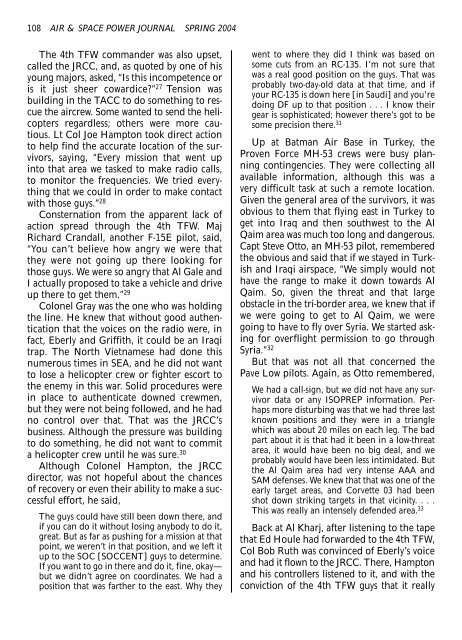presentation departments reproduced
Spring 2004 - Air and Space Power Journal - Air Force Link
Spring 2004 - Air and Space Power Journal - Air Force Link
- No tags were found...
You also want an ePaper? Increase the reach of your titles
YUMPU automatically turns print PDFs into web optimized ePapers that Google loves.
108 AIR & SPACE POWER JOURNAL SPRING 2004<br />
The 4th TFW commander was also upset,<br />
called the JRCC, and, as quoted by one of his<br />
young majors, asked, “Is this incompetence or<br />
is it just sheer cowardice?” 27 Tension was<br />
building in the TACC to do something to rescue<br />
the aircrew. Some wanted to send the helicopters<br />
regardless; others were more cautious.<br />
Lt Col Joe Hampton took direct action<br />
to help find the accurate location of the survivors,<br />
saying, “Every mission that went up<br />
into that area we tasked to make radio calls,<br />
to monitor the frequencies. We tried everything<br />
that we could in order to make contact<br />
with those guys.” 28<br />
Consternation from the apparent lack of<br />
action spread through the 4th TFW. Maj<br />
Richard Crandall, another F-15E pilot, said,<br />
“You can’t believe how angry we were that<br />
they were not going up there looking for<br />
those guys. We were so angry that Al Gale and<br />
I actually proposed to take a vehicle and drive<br />
up there to get them.” 29<br />
Colonel Gray was the one who was holding<br />
the line. He knew that without good authentication<br />
that the voices on the radio were, in<br />
fact, Eberly and Griffith, it could be an Iraqi<br />
trap. The North Vietnamese had done this<br />
numerous times in SEA, and he did not want<br />
to lose a helicopter crew or fighter escort to<br />
the enemy in this war. Solid procedures were<br />
in place to authenticate downed crewmen,<br />
but they were not being followed, and he had<br />
no control over that. That was the JRCC’s<br />
business. Although the pressure was building<br />
to do something, he did not want to commit<br />
a helicopter crew until he was sure. 30<br />
Although Colonel Hampton, the JRCC<br />
director, was not hopeful about the chances<br />
of recovery or even their ability to make a successful<br />
effort, he said,<br />
The guys could have still been down there, and<br />
if you can do it without losing anybody to do it,<br />
great. But as far as pushing for a mission at that<br />
point, we weren’t in that position, and we left it<br />
up to the SOC [SOCCENT] guys to determine.<br />
If you want to go in there and do it, fine, okay—<br />
but we didn’t agree on coordinates. We had a<br />
position that was farther to the east. Why they<br />
went to where they did I think was based on<br />
some cuts from an RC-135. I’m not sure that<br />
was a real good position on the guys. That was<br />
probably two-day-old data at that time, and if<br />
your RC-135 is down here [in Saudi] and you’re<br />
doing DF up to that position . . . I know their<br />
gear is sophisticated; however there’s got to be<br />
some precision there. 31<br />
Up at Batman Air Base in Turkey, the<br />
Proven Force MH-53 crews were busy planning<br />
contingencies. They were collecting all<br />
available information, although this was a<br />
very difficult task at such a remote location.<br />
Given the general area of the survivors, it was<br />
obvious to them that flying east in Turkey to<br />
get into Iraq and then southwest to the Al<br />
Qaim area was much too long and dangerous.<br />
Capt Steve Otto, an MH-53 pilot, remembered<br />
the obvious and said that if we stayed in Turkish<br />
and Iraqi airspace, “We simply would not<br />
have the range to make it down towards Al<br />
Qaim. So, given the threat and that large<br />
obstacle in the tri-border area, we knew that if<br />
we were going to get to Al Qaim, we were<br />
going to have to fly over Syria. We started asking<br />
for overflight permission to go through<br />
Syria.” 32<br />
But that was not all that concerned the<br />
Pave Low pilots. Again, as Otto remembered,<br />
We had a call-sign, but we did not have any survivor<br />
data or any ISOPREP information. Perhaps<br />
more disturbing was that we had three last<br />
known positions and they were in a triangle<br />
which was about 20 miles on each leg. The bad<br />
part about it is that had it been in a low-threat<br />
area, it would have been no big deal, and we<br />
probably would have been less intimidated. But<br />
the Al Qaim area had very intense AAA and<br />
SAM defenses. We knew that that was one of the<br />
early target areas, and Corvette 03 had been<br />
shot down striking targets in that vicinity. . . .<br />
This was really an intensely defended area. 33<br />
Back at Al Kharj, after listening to the tape<br />
that Ed Houle had forwarded to the 4th TFW,<br />
Col Bob Ruth was convinced of Eberly’s voice<br />
and had it flown to the JRCC. There, Hampton<br />
and his controllers listened to it, and with the<br />
conviction of the 4th TFW guys that it really
















